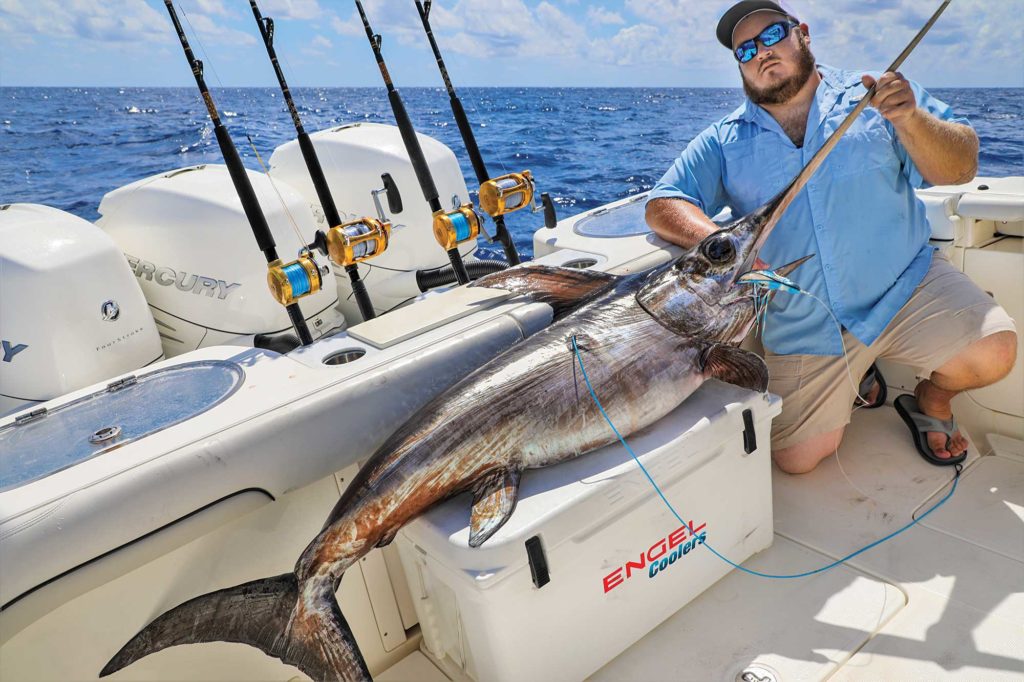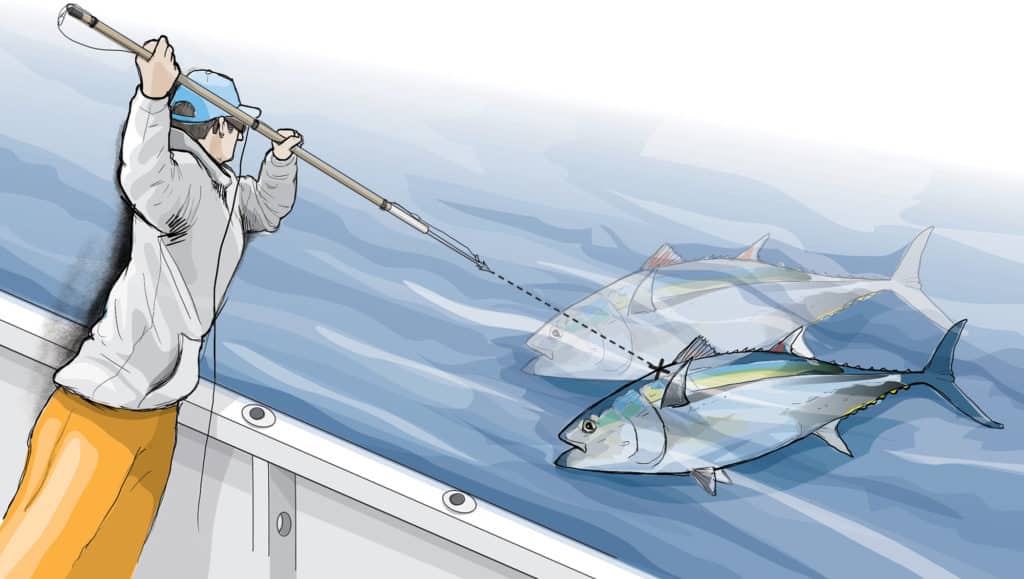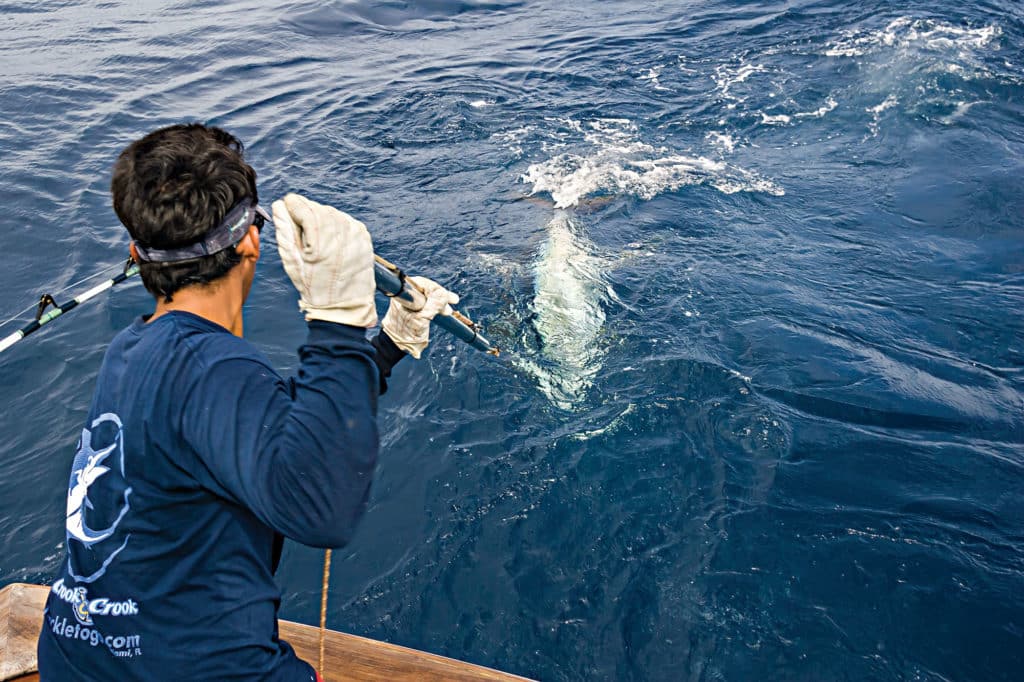
According to the IGFA rulebook, gaffs (including flying gaffs) are acceptable, provided overall length doesn’t exceed 8 feet. Harpoons, however, are not IGFA-legal landing aids. But what’s the consensus on using harpoons when seeking big fish for table fare and not tournament or record consideration?
Pointed Intentions
A harpoon dart is an alternative to a straight or flying gaff when subduing large offshore gamefish. Similar to a flying gaff, a harpoon dart detaches from its shank. But that’s pretty much it for similarities. Whereas the end of a 30-foot flying-gaff rope (IGFA max length) is cleated off, the end of a harpoon dart line—as long as 300 feet, based on specific applications—is typically secured to a buoy, which is rigged to facilitate the quick attachment of a second fishing outfit, should a fish run out all the dart line. One method relies on using the boat to stop, tire and subdue a fish; another enables the fish to tire itself, under measured pressure.
Ambition Versus Safety
There’s often an opportunity to reach a hooked fish early in the fight. With swordfish, that moment usually transpires as it reaches the surface after swimming up the weight. If a well-honed crew gets within darting distance, it has pretty much eliminated the risk of a prolonged fight and pulled hook, which are common in this fishery. While such aggressive darting may raise some eyebrows, a harpoon provides a huge safety advantage. The sheer power of a swordfish, coupled with its long bill, poses serious risk to crewmembers wiring and gaffing the fish, particularly those with little big-game experience. There’s also potential for boat damage.
Capt. Tom Daffin has daytime swordfishing off South Jersey dialed in, with a 445-pounder his largest to date. He swears by the safety factor harpoons provide. “These fish are powerful and wild and, by the boat, pose a big danger,” Daffin says. “They jump a lot and beat the hell out of a boat. Prior to using the harpoon, I recall wiring a swordfish that went crazy when it was gaffed. The gaff and the guy holding it were flailing, and the end of the gaff whacked me hard in the head. It nearly had me down for the count. With a harpoon, the dart hits the fish away from the boat. By the time it’s ready to boat, the fish is pretty much done, and everyone on board is a lot safer because of it.”
Shorter Standoffs
Daffin also darts tuna and any mako sharks he plans to keep. With tuna, it’s not only the large ones that are worthy of the dart. “I use it on 50- and 60-pounders, where I scale down to 30-pound leaders. Sometimes they’ll hold 20 feet away from the boat. The longer the standoff, the better the odds of them wearing through the leader. Whenever a tuna gets within darting range, I’m going for it.”
Swordfish and sharks are also known for standoffs near the boat. Recently, Chase Fulton and I went 1 for 2 on swords. The first fish threw the hook. We had an opportunity to reach it after it initially surfaced, but it was a small fish. The next sword was larger, and we wanted it for table fare. We never had an early shot at this one, but Fulton ended the fight when the fish dug in 15 feet beneath the boat. Pulled hooks are always a concern and quite disheartening after a drawn-out fight.
Harpoon Basics
Harpoon designs cater to specific types of fishing. There are also various ways to rig them. “I’m a Poon Harpoons guy,” Daffin says. “The shaft is aluminum with a weighted head. It’s made for throwing, unlike fiberglass shafts, which are more for poking at a fish. If I want to throw 30 feet, it’ll let me. Plus, I can put serious power behind it. This is important for penetrating tuna, which are firmer than swordfish.”
Harpoons are available as components or complete kits. For example, the kit offered by Poon Harpoons comes with the bronze dart rigged to 5 feet of coated cable, plus a shank, weighted head, two 4-foot shafts, a coupler, end cap and storage bag. A harpoon basket, which includes 100 feet of ⅜-inch line with two spliced loops, and a buoy, comes at an extra charge.
Basic harpoon rigging requires the main line be clipped onto the loop of the coated cable carrying the dart. The main line is taped or rubber-banded—as Daffin prefers—to the shaft, to keep the dart from falling off. The main line is run through a carabiner at the shaft’s cap. The bitter end of the main line (in the basket) is attached to the buoy, which is rigged with a large mono loop that serves as a quick attachment point for the snap swivel of a second fishing outfit, if needed.

Refraction Distraction
Darting a fish 10 to 20 feet down requires compensating for refraction; from a topside view, the fish’s exact position might skew slightly from where it actually is. “When I’m ready to launch the harpoon, I aim at the bottom of the fish,” Fulton says. “The hit is usually good and higher up. I also start with the head of the harpoon already in the water rather than shoot it from the surface. This way, I can power it down straight and true.”
Daffin agrees with the aim-lower concept. “Many a top tuna and swordfish harpooner has told me that, when in doubt, you should hit low. For instance, if a fish is 10 to 15 feet down and, let’s say, crossing right to left, I’ll aim for the lower stomach. Then my shot usually ends up midway in the fish.”
Do’s and Don’ts
Prior to darting a fish, clear everyone and everything in the path of the main line. Based on fish size, have a second fishing outfit ready to attach to the buoy. Upon sticking a fish, do not cleat the line or put excessive pressure on it, especially if the fish is swimming away; the dart will likely pull out if you do. Have the person on the rod continue to wind as the harpoon line is being retrieved. Once the fish is alongside the boat, a straight gaff can be used to control and bring it on board.

Sporting Thoughts?
Neither Fulton nor Daffin believe a harpoon diminishes the sport. Both think it enhances everyone’s overall safety when subduing these fish. This is especially true if the fish was cranked by hand, versus electric-reel fishing, a commercial fishing practice.
“Swordfish” Nick Stanscyk, who’s father, uncle, and family friend Vic Gaspeny pioneered daytime swordfishing off the Florida Keys, sees both sides. “Sticking a fish early on slightly takes away from the angling achievement,” he says. “Yet if you’re just out there for fun and want your best and safest shot at a sword to take home, then I don’t see anything wrong with it. If you’re going strictly by the IGFA rulebook, of course, forgo the harpoon.”
Capt. Bouncer Smith sees it slightly differently. “We didn’t carry a harpoon for years,” Smith says. “But as of late, we’ve been carrying one. I can’t honestly say we have caught or lost a swordfish due to having that harpoon aboard. However, there was one big fish that we definitely could have caught, if we’d only had a harpoon then. Overall, if an angler wants to take home some meat, which so many want to do in this fishery, I guess it’s OK. But I’m still from the school that believes hand-cranking and using a flying or straight gaff to catch a swordfish should follow IGFA standards. It’s the way this fishery was intended to be.”









